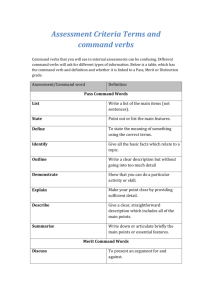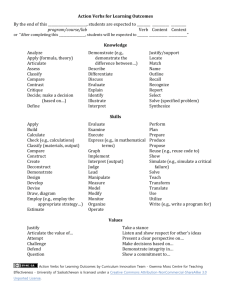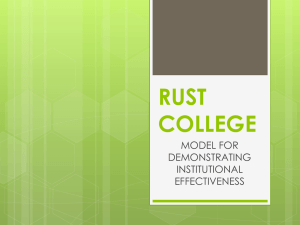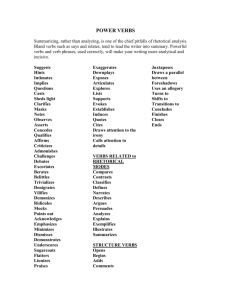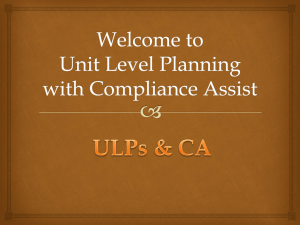Writing Student Learning Outcomes
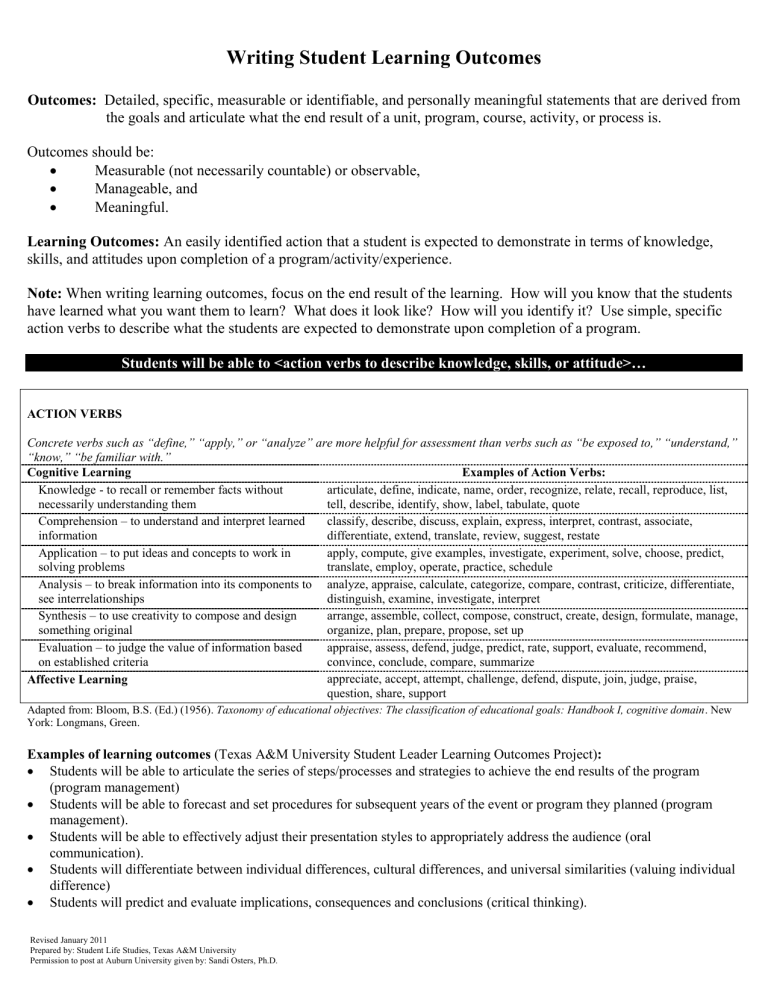
Writing Student Learning Outcomes
Outcomes: Detailed, specific, measurable or identifiable, and personally meaningful statements that are derived from the goals and articulate what the end result of a unit, program, course, activity, or process is.
Outcomes should be:
Measurable (not necessarily countable) or observable,
Manageable, and
Meaningful.
Learning Outcomes: An easily identified action that a student is expected to demonstrate in terms of knowledge, skills, and attitudes upon completion of a program/activity/experience.
Note: When writing learning outcomes, focus on the end result of the learning. How will you know that the students have learned what you want them to learn? What does it look like? How will you identify it? Use simple, specific action verbs to describe what the students are expected to demonstrate upon completion of a program.
Students will be able to <action verbs to describe knowledge, skills, or attitude>…
ACTION VERBS
Concrete verbs such as “define,” “apply,” or “analyze” are more helpful for assessment than verbs such as “be exposed to,” “understand,”
“know,” “be familiar with.”
Cognitive Learning Examples of Action Verbs:
Knowledge - to recall or remember facts without necessarily understanding them
Comprehension – to understand and interpret learned information articulate, define, indicate, name, order, recognize, relate, recall, reproduce, list, tell, describe, identify, show, label, tabulate, quote classify, describe, discuss, explain, express, interpret, contrast, associate, differentiate, extend, translate, review, suggest, restate
Application – to put ideas and concepts to work in solving problems
Analysis – to break information into its components to see interrelationships
Synthesis – to use creativity to compose and design something original
Evaluation – to judge the value of information based on established criteria apply, compute, give examples, investigate, experiment, solve, choose, predict, translate, employ, operate, practice, schedule analyze, appraise, calculate, categorize, compare, contrast, criticize, differentiate, distinguish, examine, investigate, interpret arrange, assemble, collect, compose, construct, create, design, formulate, manage, organize, plan, prepare, propose, set up appraise, assess, defend, judge, predict, rate, support, evaluate, recommend, convince, conclude, compare, summarize
Affective Learning appreciate, accept, attempt, challenge, defend, dispute, join, judge, praise, question, share, support
Adapted from: Bloom, B.S. (Ed.) (1956). Taxonomy of educational objectives: The classification of educational goals: Handbook I, cognitive domain . New
York: Longmans, Green.
Examples of learning outcomes (Texas A&M University Student Leader Learning Outcomes Project) :
Students will be able to articulate the series of steps/processes and strategies to achieve the end results of the program
(program management)
Students will be able to forecast and set procedures for subsequent years of the event or program they planned (program management).
Students will be able to effectively adjust their presentation styles to appropriately address the audience (oral communication).
Students will differentiate between individual differences, cultural differences, and universal similarities (valuing individual difference)
Students will predict and evaluate implications, consequences and conclusions (critical thinking).
Revised January 2011
Prepared by: Student Life Studies, Texas A&M University
Permission to post at Auburn University given by: Sandi Osters, Ph.D.
Writing Program, Process, and Performance Outcomes
Program/process outcomes
– The end result of what a program or process is to do, achieve, or accomplish.
Note: Program outcomes can be as simple as completion of a task or activity, although this is not as meaningful as it could be and does not provide information for improvement. To accomplish the latter, you should try to assess the effectiveness of what you want your program to accomplish. Program outcomes, just like learning outcomes should be m easurable, manageable, and meaningful.
THE PROGRAM WILL BE ABLE TO <ACTION VERB TO DESCRIBE WHAT IT WILL DO, ACHIEVE OR ACCOMPLISH>…
Performance outcome: Increase the size of the Rec Center’s Weight & Fitness Room and purchase additional equipment to increase access for Rec Center members
Program outcome: The Department of Residence Life will be able to respond to maintenance requests within 24 hours of their walk-in time
Program outcome: Develop and expand the Student Health Services web page in order to increase student access to health information, information regarding patient services and educational programming available from Student
Health Services
Program outcome: Students will determine, procure, and optimize all resources (human, material and financial) needed for a particular project
Select appropriate Assessment Methods: Means of assessment describes the process employed to gather data that will measure each stated outcome. Try to use a variety of methods, direct and indirect, quantitative and qualitative, to gather adequate information to determine the extent the outcome has been achieved.
Direct Methods - Any process employed to gather data which requires subjects to display their knowledge, behavior, or thought processes.
Indirect Methods - Any process employed to gather data which asks subjects to reflect upon their knowledge, behaviors, or thought processes.
Some Examples of Direct Assessment Methods
Student work samples
Collections of student work (e.g. Portfolios)
Capstone projects
Project-embedded assessment
Observations of student behavior
External evaluations of student performance
Performance on a case study/problem
Performance on problem and analysis
Locally developed tests
Standardized tests
Pre-and post-tests
Essay tests blind scored across units
Supervisor/advisor evaluations
Certificates of completion/compliance
Reflective Journals
Some Examples of Other Assessment Methods
Alumni, employer, student surveys
Focus groups and interviews
Exit Interviews with graduates
Graduate follow-up studies
Retention and transfer studies
Job placement statistics
Percentage of students who study abroad
Enrollment trends
One minute papers/cards
Exit interviews
Program Review using standards
Benchmarking
Student leadership transcripts
Timelines and budgets
Tracking use of services (attendance, ticket sales, clients, etc.)
Tracking program participation by desired demographics
Document analysis (e.g., meeting minutes, policies, handbooks)
Learning contracts
Revised January 2011
Prepared by: Student Life Studies, Texas A&M University
Permission to post at Auburn University given by: Sandi Osters, Ph.D.
